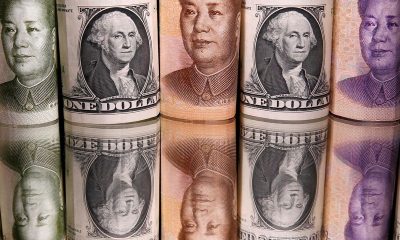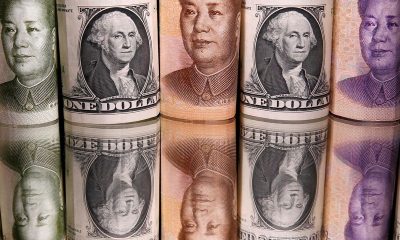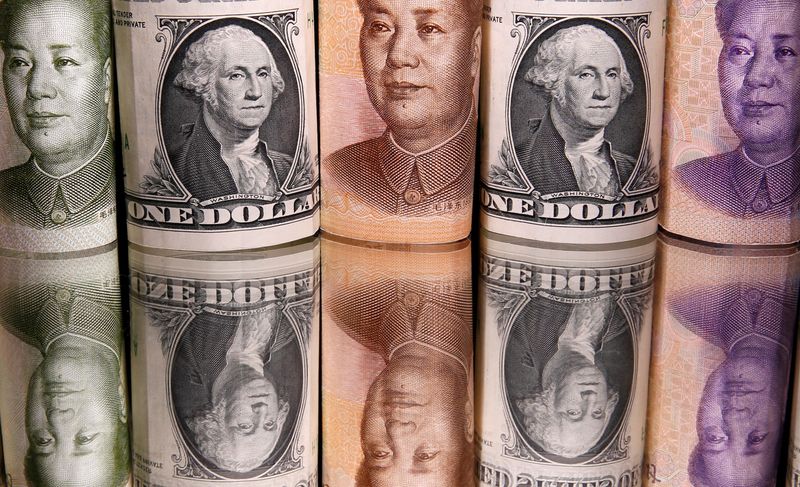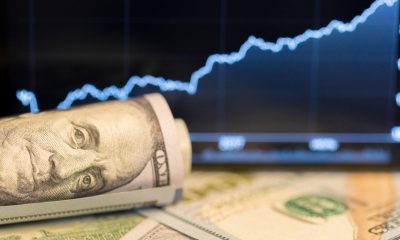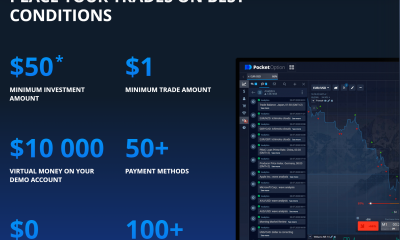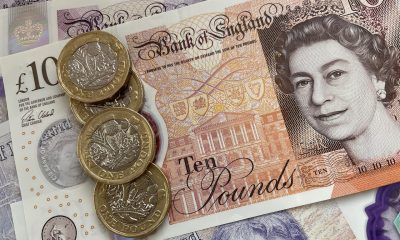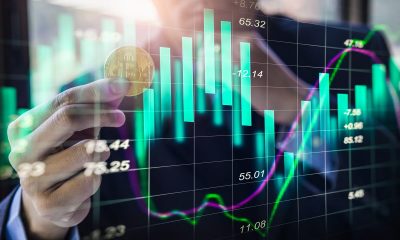Forex
Yuan slides after PBOC, dollar little changed on MLK Day
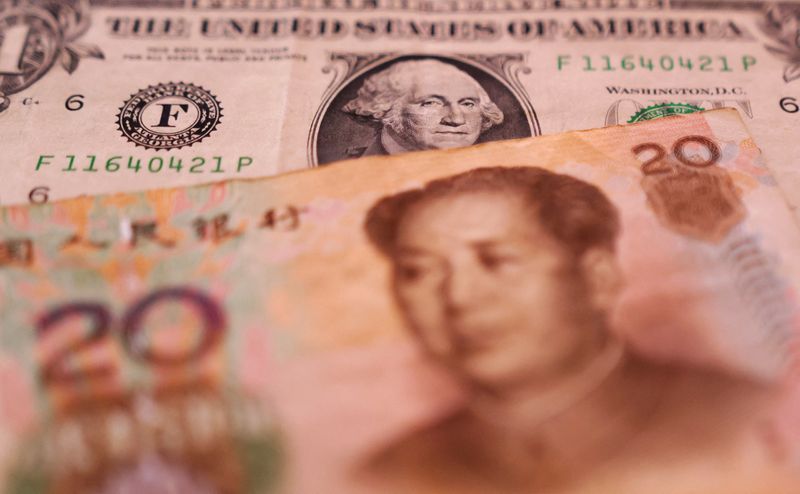
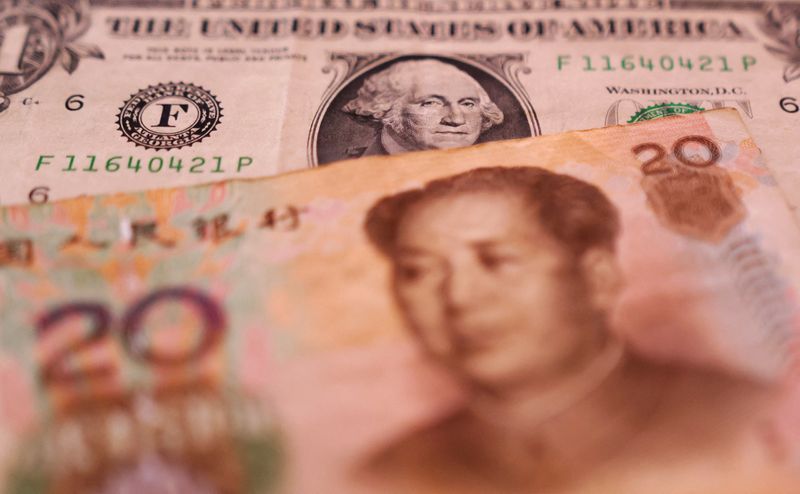
© Reuters. U.S. Dollar and Chinese Yuan banknotes are seen in this illustration taken January 30, 2023. REUTERS/Dado Ruvic/Illustration
By Joice Alves and Rae Wee
LONDON/SINGAPORE (Reuters) -The yuan fell on Monday to a one-month low after China’s central bank surprised markets by keeping its medium-term policy rate steady, while the dollar was little changed on Martin Luther King (MLK) Jr. Day, a public holiday.
The People’s Bank of China (PBOC) left interest rates unchanged when rolling over maturing medium-term policy loans, defying market expectations for a cut to shore up China’s bumpy post-pandemic economic recovery.
That sent the sliding to a one-month low of 7.1813 per dollar before recouping some of those losses to trade down 0.08% at 7.1749.
Its offshore counterpart fell as far as 7.1906 per dollar, languishing near Friday’s one-month trough.
“China’s central bank kept its medium-term lending facility rate unchanged at 2.5%, contrary to the widespread consensus of a 10 basis points cut,” said Tommy Wo, senior economist at Commerzbank (ETR:).
However, rate cuts are still on the table, he added.
“The U.S. Fed’s pivot has allowed the PBoC to conduct more accommodative monetary policy. There will be more room for PBoC rate cuts when the timing of Fed’s rate reduction becomes clearer”.
China’s fourth-quarter gross domestic product (GDP), December industrial production, retail sales and unemployment rate are among the key economic indicators out on Wednesday, which are likely to provide further clarity on the outlook for the world’s second-largest economy.
The , measuring the U.S. currency against six peers, was little changed up 0.07% to 102.58, ahead of the U.S. Martin Luther King Day holiday on Monday.
Bets for Fed cuts this year, beginning as early as March, have risen after data on Friday showed U.S. producer prices unexpectedly fell in December, sending Treasury yields sliding in response. [US/]
“Despite the upside surprise to the CPI on Thursday, investors grew increasing confident that the Fed is likely to cut rates soon,” said Jim Reid, strategist at Deutsch Bank.
Market pricing now points to a 77% chance that the U.S. central bank will begin easing rates in March, as compared to a 68% chance a week ago, according to the CME FedWatch tool.
In the broader market, traders also have their eye on a reading on UK inflation due later in the week, as the market focus remains on how soon major central banks globally could begin easing rates this year.
Sterling slipped 0.2% to $1.2725, though it remained close to a two-week peak hit last week.
The euro hovered near the $1.10 mark and was last flat on the day at $1.0946.
In Asia, the yen remained under pressure, down 0.5% at 145.69 per dollar on expectations that the Bank of Japan is likely to keep its ultra-loose policy settings unchanged at its upcoming policy meeting next week.
TAIWAN AFTER THE ELECTION
Elsewhere, the Taiwan dollar fell to a more than three-week low of 31.284 per U.S. dollar, after the Democratic Progressive Party’s (DPP) Lai Ching-te won the presidency over the weekend, though his party lost its majority in parliament
Analysts expect Taiwan’s stock market to take a hit this week as the spectre of policy paralysis fuels selling in a market that is up 25% in little more than a year.
“DPP lost the majority in the parliament. Hence Lai is ruling with a weaker mandate than Tsai Ing-wen,” said Allan von Mehren, director at Danske Bank.
He expects continued tensions in the Taiwan Strait but not a further escalation.
“China will continue to deter Taiwanese independence with military drills around the island and Taiwan and the U.S. are likely to continue to have closer relations but without crossing China’s red line”.

 Forex3 years ago
Forex3 years agoForex Today: the dollar is gaining strength amid gloomy sentiment at the start of the Fed’s week

 Forex3 years ago
Forex3 years agoUnbiased review of Pocket Option broker

 Forex3 years ago
Forex3 years agoDollar to pound sterling exchange rate today: Pound plummeted to its lowest since 1985

 Forex3 years ago
Forex3 years agoHow is the Australian dollar doing today?

 Cryptocurrency3 years ago
Cryptocurrency3 years agoWhat happened in the crypto market – current events today

 World3 years ago
World3 years agoWhy are modern video games an art form?

 Commodities3 years ago
Commodities3 years agoCopper continues to fall in price on expectations of lower demand in China

 Economy3 years ago
Economy3 years agoCrude oil tankers double in price due to EU anti-Russian sanctions

